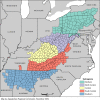Assessing health disparities in breast cancer incidence burden in Tennessee: geospatial analysis
- PMID: 33941168
- PMCID: PMC8091807
- DOI: 10.1186/s12905-021-01274-9
Assessing health disparities in breast cancer incidence burden in Tennessee: geospatial analysis
Abstract
Background: Tennessee women experience the 12th highest breast cancer mortality in the United States. We examined the geographic differences in breast cancer incidence in Tennessee between Appalachian and non-Appalachian counties from 2005 to 2015.
Methods: We used ArcGIS 10.7 geospatial analysis and logistic regression on the Tennessee Cancer Registry incidence data for adult women aged ≥ 18 years (N = 59,287) who were diagnosed with breast cancer from 2005 to 2015 to evaluate distribution patterns by Appalachian county designation. The Tennessee Cancer Registry is a population-based, central cancer registry serving the citizens of Tennessee and was established by Tennessee law to collect and monitor cancer incidence. The main outcome was breast cancer stage at diagnosis. Independent variables were age, race, marital status, type of health insurance, and county of residence.
Results: Majority of the sample were White (85.5%), married (58.6%), aged ≥ 70 (31.3%) and diagnosed with an early stage breast cancer (69.6%). More than half of the women had public health insurance (54.2%), followed by private health insurance coverage (44.4%). Over half of the women resided in non-Appalachian counties, whereas 47.6% were in the Appalachian counties. We observed a significant association among breast cancer patients with respect to marital status and type of health insurance coverage (p = < 0.0001). While the logistic regression did not show a significant result between county of residence and breast cancer incidence, the spatial analysis revealed geographic differences between Appalachian and non-Appalachian counties. The highest incidence rates of 997.49-1164.59/100,000 were reported in 6 Appalachian counties (Anderson, Blount, Knox, Rhea, Roane, and Van Buren) compared to 3 non-Appalachian counties (Fayette, Marshall, and Williamson).
Conclusions: There is a need to expand resources in Appalachian Tennessee to enhance breast cancer screening and early detection. Using geospatial techniques can further elucidate disparities that may be overlooked in conventional linear analyses to improve women's cancer health and associated outcomes.
Keywords: Appalachian Tennessee; Breast cancer; Geographic information system; Health disparities; Non-appalachian Tennessee.
Conflict of interest statement
The authors declare no conflict of interest.
Figures
Similar articles
-
Sociodemographic Factors and Health Insurance Coverage Are Associated with Invasive Breast Cancer in Tennessee: Appalachian and Non-Appalachian County Comparison.Womens Health Rep (New Rochelle). 2022 May 20;3(1):543-551. doi: 10.1089/whr.2021.0136. eCollection 2022. Womens Health Rep (New Rochelle). 2022. PMID: 35651993 Free PMC article.
-
Applying Latent Class Analysis on Cancer Registry Data to Identify and Compare Health Disparity Profiles in Colorectal Cancer Surgical Treatment Delay.J Public Health Manag Pract. 2022 Mar-Apr 01;28(2):E487-E496. doi: 10.1097/PHH.0000000000001341. J Public Health Manag Pract. 2022. PMID: 33729186 Free PMC article.
-
Geographic disparities in adherence to adjuvant endocrine therapy in Appalachian women with breast cancer.Res Social Adm Pharm. 2017 Jul-Aug;13(4):796-810. doi: 10.1016/j.sapharm.2016.08.004. Epub 2016 Aug 25. Res Social Adm Pharm. 2017. PMID: 27641308 Free PMC article.
-
Risk Factors for Pediatric Facial Trauma in an Appalachian Region: An Epidemiological Review at a Single Institution.J Oral Maxillofac Surg. 2024 Mar;82(3):306-313. doi: 10.1016/j.joms.2023.12.010. Epub 2023 Dec 26. J Oral Maxillofac Surg. 2024. PMID: 38191125 Review.
-
Disparities in Advanced Stage Colorectal Cancer Outcomes in Appalachia: A Comprehensive Review.Am Surg. 2025 Apr;91(4):633-638. doi: 10.1177/00031348241312124. Epub 2025 Jan 3. Am Surg. 2025. PMID: 39749412 Review.
Cited by
-
Sociodemographic Factors and Health Insurance Coverage Are Associated with Invasive Breast Cancer in Tennessee: Appalachian and Non-Appalachian County Comparison.Womens Health Rep (New Rochelle). 2022 May 20;3(1):543-551. doi: 10.1089/whr.2021.0136. eCollection 2022. Womens Health Rep (New Rochelle). 2022. PMID: 35651993 Free PMC article.
-
Differences in Distress Between Rural and Non-rural Appalachian Breast Cancer Patient/Caregiver Dyads During the First Year of Treatment.J Appalach Health. 2023 Jan 1;4(3):56-70. doi: 10.13023/jah.0403.04. eCollection 2023. J Appalach Health. 2023. PMID: 38026046 Free PMC article.
-
Nomograms predict survival of patients with lymph node-positive, luminal a breast cancer.BMC Cancer. 2021 Aug 28;21(1):965. doi: 10.1186/s12885-021-08642-6. BMC Cancer. 2021. PMID: 34454451 Free PMC article.
-
Breast cancer incidence in Yogyakarta, Indonesia from 2008-2019: A cross-sectional study using trend analysis and geographical information system.PLoS One. 2023 Jul 5;18(7):e0288073. doi: 10.1371/journal.pone.0288073. eCollection 2023. PLoS One. 2023. PMID: 37406000 Free PMC article.
-
A Multiscale Spatiotemporal Epidemiological Analysis of Neighborhood Correlates of Triple-Negative Breast Cancer.Cancer Epidemiol Biomarkers Prev. 2024 Feb 6;33(2):279-287. doi: 10.1158/1055-9965.EPI-22-1255. Cancer Epidemiol Biomarkers Prev. 2024. PMID: 37971370 Free PMC article.
References
-
- Hunt BR, Whitman S, Hurlbert MS. Increasing Black: White disparities in breast cancer mortality in the 50 largest cities in the United States. Cancer Epidemiol. 2014;38(2):118–123. - PubMed
-
- Williams F, Jeanetta S, James AS. Geographical location and stage of breast cancer diagnosis: a systematic review of the literature. J Health Care Poor Underserved. 2016;27(3):1357–1383. - PubMed
-
- The Appalachian Region https://www.arc.gov/appalachian_region/TheAppalachianRegion.asp. Accessed 17 Dec 2020.
-
- Marshall J, Thomas L, Lane N, Holmes G, Arcury T, Randolph R, Silberman P, Holding W, Villamil Lea: Health Disparities in Appalachia August 2017: Creating a culture of health in Appalachia: disparities and bright spots https://www.arc.gov/research/researchreportdetails.asp?REPORT_ID=138. Accessed 16 July 2019.
-
- Behringer B, Friedell GH, Dorgan KA, Hutson SP, Naney C, Phillips A, Cantrell E. Understanding the challenges of reducing cancer in Appalachia: addressing a place-based health disparity population. Calif J Health Promot. 2007;5:40–49.
Publication types
MeSH terms
LinkOut - more resources
Full Text Sources
Other Literature Sources
Medical



